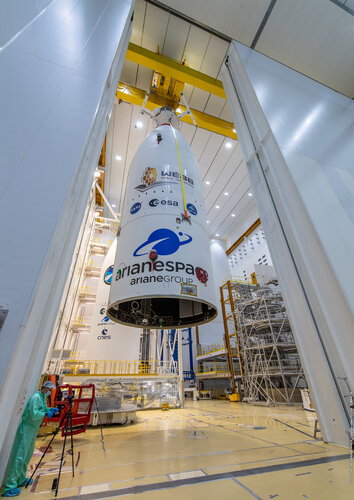

Access the video
Earlier this week, Webb was placed on top of Ariane 5 and a protective ‘shower curtain’ was put up to avoid any contamination.
On the day of encapsulation in the fairing, a protective cover on top of Webb was removed and the fairing was lowered down over the observatory and locked in place for liftoff.
This was a particularly delicate operation, assisted by a laser guiding system, because the margins between the folded up observatory (4.5 m wide) and the rocket fairing (5.4 m wide) are small.
The fairing is equipped with specialised environmental controls that keep the observatory in a perfectly controlled temperature and humidity range during its final few days on Earth.
Now that Webb has been securely attached to its Ariane 5 launch vehicle, and enclosed within its protective fairing, mechanical operations involving the observatory at its launch site in French Guiana have formally concluded.
Final electrical and software configurations will occur on the launch pad during the final hours before liftoff. Webb will switch to internal battery power roughly 20 minutes prior to liftoff, and within 15 minutes prior the observatory and its launch vehicle will both be fully cleared for flight.
Ariane 5’s rollout to the launch pad is scheduled to begin Wednesday 22 December, and this is where final health checks and preparations for liftoff will occur.
Webb will be the largest, most powerful telescope ever launched into space. As part of an international collaboration agreement, ESA is providing the telescope’s launch service using the Ariane 5 launch vehicle. Working with partners, ESA was responsible for the development and qualification of Ariane 5 adaptations for the Webb mission and for the procurement of the launch service by Arianespace.
Webb is an international partnership between NASA, ESA and the Canadian Space Agency (CSA).
Find out more about Webb in ESA’s launch kit and interactive brochure.



